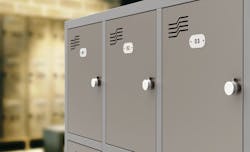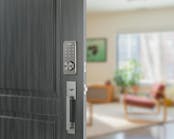Business leaders see pent-up demand and high economic growth in coming months. In addition, recent healthcare issues and perpetual civil unrest will increase security budgets. That’s a good thing.
Physical security and liability always have driven electronic access control (EAC) upgrades. However, providing a reasonable level of safety for students, patients and employees has become an important liability issue. Many school, college and church campuses are installing remote electronic lockdown equipment, protecting individual rooms, zones or buildings. Compliance with the Americans with Disabilities Act (ADA) and safety codes continues to be important as well. Even if you don’t have the contract, installation subcontracts often are available.
Meanwhile, improvements in the cost, performance and reliability now place EAC upgrades within the reach of thousands of additional customers. Benefits include audit trails, door and latch sensors, tamper alarms and rapid updates.
Key control is a big concern with just about any application. Although patented keying has a temporary effect on distribution and duplication, a user’s internal key-control process makes it last. Ongoing success depends on identifying and updating or rendering obsolete illegitimate keys. The process is the same for credentials, but electronic upgrades greatly enhance speed, accountability and recovery. Electronics also allow the customer to maintain internal control over much longer periods.
The bottom line is that although the COVID-19 pandemic has triggered a focus on touchless and low-touch solutions — a so-called new world order — those systems aren’t the only game in town. Low-energy operators, electronic cabinet locks and remote-site security for critical infrastructure are areas of emerging opportunity for security pros.
One such area is data protection. Data protection always has been a big deal in large computer centers. Protecting customer information now has become a critical component of every small business, medical office, pharmacy or just about any place where customer information is held or processed. CyberLock, HES and RCI all build “server rack” modules that have electronic as well as keyed options.
Following are other areas ripe for electronic upgrades.
Low-Energy Operators
Assistance, convenience and code compliance increasingly are required in multitenant housing, retirement communities, retail, office buildings and healthcare facilities. Low-energy operators provide hands-free opening convenience when carrying packages, programmable hold-open times, hands-free sanitation solutions and ADA code compliance.
Two basic types of low-energy operators are in general use. The electrohydraulic operator uses an electric motor to open a door while a built-in standard closer returns the door. These often are used with manual operation or with power-opening when triggered by a push bar, touchless sensor or other initiating device. LCN also has a pneumatic version that works well in hazardous environments. The electromechanical type of operator uses a motor-gearbox to perform opening and closing functions. Both types are available from most suppliers.
Norton and Precision Hardware offer object-sensor models to keep the door open while traffic flows through. This is particularly useful in high-traffic applications, such as churches, theaters and schools. Norton added smart programming to some models, which allows a full range of adjustments via a mobile app without the use of ladders or additional hygienic measures during adjustments. Norton also offers the unique 5800 series closer, which uses regenerative power (with battery backup) for operation where energy conservation or power interruption are issues.
Other typical innovations include power close for high wind or stack pressure, latch assist to insure secure closure, obstruction detection, programmable or infinite hold-open, electrified lock, exit device or strike sequencing, and vestibule coordination applications. Other respected players in this market include Detex, Hager and SDC.
Electrifying existing exit devices continues to be a strong growth market. All major exit device players offer electronic upgrade kits. Architectural Control Systems, Command Access and SDC are well-known for retrofit electrification kits for exit devices as well.
Cabinets, Drawers and Lockers
Cabinets, drawers and lockers have seen a lot of electronic development in the past few years. A huge market opportunity exists for electronic upgrades to the many millions of drawers, cabinets, files, showcases and lockers secured by BEST-style small-format interchangeable core (SFIC) cylinders.
Millions of these SFIC drawer and cabinet locks can be found in car rentals, airlines, schools, colleges, military bases, labs and industry — anyplace there are a lot of doors, people and something of value to protect.
SFIC-secured enclosures that contain jewelry, pharmaceuticals, weapons, important documents and other valuable materials are prime candidates for the BEST Switch Core. The Switch Core and the dormakaba 21 10 cabinet lock are part of a complete line of products that include Bluetooth Low Energy operation. RCI also produces a considerable line of electronic cabinet, drawer and server rack locks.
CLIQ products from ASSA ABLOY’s various companies also can be effective solutions in these locations that generally present inconvenient wiring options for high-value assets.
HES, an ASSA ABLOY brand, provides an array of drawer, cabinet file and server lock assemblies, including the entry-level card-operated K20 and keypad KP20 cabinet locks.
BLE has become the standard for EAC because of its hands-free operation, programmable transmission distance, high speed and power available in mobile credentials. Near field communication (NFC) is popular in retail applications where a thin credit card is read from a terminal located within a few millimeters.
BLE- and NFC-enabled mobile credentials that operate the SALTO XS4 locker lock are part of an increasing collection of BLE- and NFC-enabled EAC products. With about 4 billion smartphones in use around the world, this will continue to be a growing market trend.
Critical Infrastructure
Critical Infrastructure is now a top government concern. Rogue nation players make daily attempts to penetrate these vital services. If the power grid were to go down, your Tesla wouldn’t go, your food would spoil and you might freeze. Energy, food, communications, dams, healthcare, information technology, chemicals, nuclear, water and transportation are some of the areas of concern — and an electronic upgrade opportunity.
The U.S. Cybersecurity & Infrastructure Security Agency published a list of sector-specific plans. (www.cisa.gov/2015-sector-specific-plans) The document states that “Best Security Practices” should be applied to assess vulnerabilities and harden the sites. Clearly, electronic upgrades are an important component of these upgrade plans.
Every city in North America has unmanned traffic-control cabinets. These enclosures are seen on thousands of street corners. Traffic-control cabinets are listed as a part of the critical infrastructure. There’s considerable interest in electronic upgrades to secure and monitor these cabinets. The HES 630REL Series provides real-time access control and monitoring in the extreme environments these cabinets face.
Remote sites typically have lower bandwidth SCADA (supervisory control and data acquisition) monitoring and control. Internet protocols have allowed much higher transmission speeds, with associated improvements in security options. The tradeoff is they become hacker targets.
Many of these remote locations are good candidates for smart keys, such as CyberLock and the Medeco XT. These are particularly effective for high-security locks in remote areas where hard-wiring or radio-frequency (RF) transmission isn’t available.
Commercial and Multitenant Housing
Commercial applications, including office, industrial, educational, retail and military, face security challenges. These issues range from audit trails, after-hours accountability and defense against hostile attacks, to defending against back-door pilferage. College dorms are particularly vulnerable to doors being propped open, which allows unauthorized entrance.
Adams Rite has an excellent brochure titled “Mechanical to Electrical” that covers a wide range of upgrades for storefront and other commercial doors. Electrified exit devices, the Steel Hawk electrified deadlatch, Dual Force interconnected locks, eForce keyless entry and a complete line of electric strikes provide a wide range of solutions.
A more recent entry in the commercial and multifamily market is the pdqSMART line. Cylindrical, mortise, deadbolt, exit trim and switching controls are included. These locks can be operated by key, PIN, RFID card, smartphone or smart watch, can connect to Google Alexa devices and support two-factor authentication.
Another entry into the mobile credential sweepstakes is the Securitech BT Series. This BLE-enabled app uses your mobile credential to connect with exterior trim for a wide variety of heavy-duty and extreme-duty Securitech locking systems. These robust devices have become highly regarded in the security (and pilferage) conscious cannabis industry.
Delayed-egress upgrades also continue to be an important market. Countless thousands of retail, restaurant, college and manufacturing facilities feature fire-hazard rear exit nightmares, such as the ones shown on iDigHardware.com.
So, the new world order certainly is different. But remember: Many existing jobs have profitable opportunities hidden nearby.
An early innovator in the EAC business shared a sales strategy that paid off for him. We took his advice and paid our mechanical people a 1% commission for any electronics sold to their customers.
Alert technicians offered helpful upgrade suggestions that improved the customer’s safety and their own job security, and our electronic sales grew by several million dollars. I’m glad we took the advice.
Cameron Sharpe, CPP, worked 30 years in the commercial lock and electronic access industry. Contact him at [email protected].
Tools for Electronic Upgrades
Electronic upgrades live and die with the indispensable digital multimeter that measures amps, volts and resistance. A few other tools often are useful for this line of work. The tone generator is extremely helpful in locating which wire comes from a remote location.
I wish my technicians would have had the 7000-DGK drill fixture kit from SDC. It saves a lot of time and anxiety. Several excellent training documents are available on the SDC website, www.sdcsecurity.com.
Wireless power-transfer devices, such as SDC’s WPT and Securitron’s PowerJump provide 6–7 watts of wireless power for electrified locks. The Command Access PM300 power poster can deliver 1.5 amps of local pull-in power when long wire runs can’t deliver.
Power over Ethernet gets interesting. I won’t get into the latest IEEE standards, but be aware of what actually is being delivered. Platinum Tools sells a pocket-size PoE Tester that has multiple ports and jacks. Command Access also provides a Cat Field Tester that carries its own 12VDC or 24VDC power source for field-testing lock devices.
Cameron Sharpe
Cameron Sharpe, CPP, worked 30 years in the commercial lock and electronic access industry. Contact him at [email protected].






